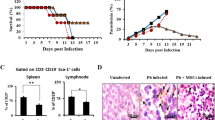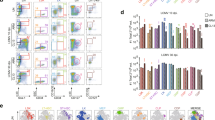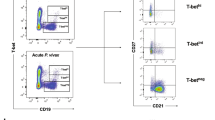Abstract
Although the relationship between hematopoietic stem cells and progenitor populations has been investigated extensively under steady-state conditions, the dynamic response of the hematopoietic compartment during acute infection is largely unknown. Here we show that after infection of mice with Plasmodium chabaudi, a c-Kithi progenitor subset positive for interleukin 7 receptor-α (IL-7Rα) emerged that had both lymphoid and myeloid potential in vitro. After being transferred into uninfected alymphoid or malaria-infected hosts, IL-7Rα+c-Kithi progenitors generated mainly myeloid cells that contributed to the clearance of infected erythrocytes in infected hosts. The generation of these infection-induced progenitors was critically dependent on interferon-γ (IFN-γ) signaling in hematopoietic progenitors. Thus, IFN-γ is a key modulator of hematopoiesis and innate and adaptive immunity during acute malaria infection.
This is a preview of subscription content, access via your institution
Access options
Subscribe to this journal
Receive 12 print issues and online access
$209.00 per year
only $17.42 per issue
Buy this article
- Purchase on Springer Link
- Instant access to full article PDF
Prices may be subject to local taxes which are calculated during checkout







Similar content being viewed by others
References
Passegué, E., Wagers, A.J., Giuriato, S., Anderson, W.C. & Weissman, I.L. Global analysis of proliferation and cell cycle gene expression in the regulation of hematopoietic stem and progenitor cell fates. J. Exp. Med. 202, 1599–1611 (2005).
Adolfsson, J. et al. Upregulation of Flt3 expression within the bone marrow Lin−Sca1+c-kit+ stem cell compartment is accompanied by loss of self-renewal capacity. Immunity 15, 659–669 (2001).
Kiel, M.J., Yilmaz, O.H., Iwashita, T., Terhorst, C. & Morrison, S.J. SLAM family receptors distinguish hematopoietic stem and progenitor cells and reveal endothelial niches for stem cells. Cell 121, 1109–1121 (2005).
Osawa, M., Hanada, K., Hamada, H. & Nakauchi, H. Long-term lymphohematopoietic reconstitution by a single CD34-low/negative hematopoietic stem cell. Science 273, 242–245 (1996).
Luc, S., Buza-Vidas, N. & Jacobsen, S.E. Delineating the cellular pathways of hematopoietic lineage commitment. Semin. Immunol. 20, 213–220 (2008).
Kondo, M., Weissman, I.L. & Akashi, K. Identification of clonogenic common lymphoid progenitors in mouse bone marrow. Cell 91, 661–672 (1997).
Akashi, K., Traver, D., Miyamoto, T. & Weissman, I.L. A clonogenic common myeloid progenitor that gives rise to all myeloid lineages. Nature 404, 193–197 (2000).
Adolfsson, J. et al. Identification of Flt3+ lympho-myeloid stem cells lacking erythro-megakaryocytic potential a revised road map for adult blood lineage commitment. Cell 121, 295–306 (2005).
Arinobu, Y. et al. Reciprocal activation of GATA-1 and PU.1 marks initial specification of hematopoietic stem cells into myeloerythroid and myelolymphoid lineages. Cell Stem Cell 1, 416–427 (2007).
Milne, C.D. & Paige, C.J. IL-7: a key regulator of B lymphopoiesis. Semin. Immunol. 18, 20–30 (2006).
Kondo, M. et al. Cell-fate conversion of lymphoid-committed progenitors by instructive actions of cytokines. Nature 407, 383–386 (2000).
Langhorne, J., Ndungu, F.M., Sponaas, A.M. & Marsh, K. Immunity to malaria: more questions than answers. Nat. Immunol. 9, 725–732 (2008).
Stevenson, M.M. & Riley, E.M. Innate immunity to malaria. Nat. Rev. Immunol. 4, 169–180 (2004).
Villeval, J.L., Gearing, A. & Metcalf, D. Changes in hemopoietic and regulator levels in mice during fatal or nonfatal malarial infections. II. Nonerythroid populations. Exp. Parasitol. 71, 375–385 (1990).
Nagaoka, H., Gonzalez-Aseguinolaza, G., Tsuji, M. & Nussenzweig, M.C. Immunization and infection change the number of recombination activating gene (RAG)-expressing B cells in the periphery by altering immature lymphocyte production. J. Exp. Med. 191, 2113–2120 (2000).
Zhu, J. et al. A myeloid-lineage-specific enhancer upstream of the mouse myeloperoxidase (MPO) gene. Leukemia 8, 717–723 (1994).
Zhang, P. et al. Enhancement of hematopoietic stem cell repopulating capacity and self-renewal in the absence of the transcription factor C/EBPα. Immunity 21, 853–863 (2004).
Villeval, J.L., Lew, A. & Metcalf, D. Changes in hemopoietic and regulator levels in mice during fatal or nonfatal malarial infections. I. Erythropoietic populations. Exp. Parasitol. 71, 364–374 (1990).
Yap, G.S. & Stevenson, M.M. Plasmodium chabaudi AS: erythropoietic responses during infection in resistant and susceptible mice. Exp. Parasitol. 75, 340–352 (1992).
Silverman, P.H., Schooley, J.C. & Mahlmann, L.J. Murine malaria decreases hemopoietic stem cells. Blood 69, 408–413 (1987).
Asami, M., Owhashi, M., Abe, T. & Nawa, Y. A comparative study of the kinetic changes of hemopoietic stem cells in mice infected with lethal and non-lethal malaria. Int. J. Parasitol. 22, 43–47 (1992).
Serbina, N.V., Hohl, T.M., Cherny, M. & Pamer, E.G. Selective expansion of the monocytic lineage directed by bacterial infection. J. Immunol. 183, 1900–1910 (2009).
Ueda, Y., Yang, K., Foster, S.J., Kondo, M. & Kelsoe, G. Inflammation controls B lymphopoiesis by regulating chemokine CXCL12 expression. J. Exp. Med. 199, 47–58 (2004).
Ueda, Y., Cain, D.W., Kuraoka, M., Kondo, M. & Kelsoe, G. IL-1R type I-dependent hemopoietic stem cell proliferation is necessary for inflammatory granulopoiesis and reactive neutrophilia. J. Immunol. 182, 6477–6484 (2009).
Iida, S., Watanabe-Fukunaga, R., Nagata, S. & Fukunaga, R. Essential role of C/EBPα in G-CSF-induced transcriptional activation and chromatin modification of myeloid-specific genes. Genes Cells 13, 313–327 (2008).
Hsu, C.L. et al. Antagonistic effect of CCAAT enhancer-binding protein-α and Pax5 in myeloid or lymphoid lineage choice in common lymphoid progenitors. Proc. Natl. Acad. Sci. USA 103, 672–677 (2006).
Serbina, N.V. & Pamer, E.G. Monocyte emigration from bone marrow during bacterial infection requires signals mediated by chemokine receptor CCR2. Nat. Immunol. 7, 311–317 (2006).
Tsou, C.L. et al. Critical roles for CCR2 and MCP-3 in monocyte mobilization from bone marrow and recruitment to inflammatory sites. J. Clin. Invest. 117, 902–909 (2007).
Robben, P.M., LaRegina, M., Kuziel, W.A. & Sibley, L.D. Recruitment of Gr-1+ monocytes is essential for control of acute toxoplasmosis. J. Exp. Med. 201, 1761–1769 (2005).
Sponaas, A.M. et al. Migrating monocytes recruited to the spleen play an important role in control of blood stage malaria. Blood 114, 5522–5531 (2009).
Coban, C. et al. Toll-like receptor 9 mediates innate immune activation by the malaria pigment hemozoin. J. Exp. Med. 201, 19–25 (2005).
Parroche, P. et al. Malaria hemozoin is immunologically inert but radically enhances innate responses by presenting malaria DNA to Toll-like receptor 9. Proc. Natl. Acad. Sci. USA 104, 1919–1924 (2007).
Welner, R.S. et al. Lymphoid precursors are directed to produce dendritic cells as a result of TLR9 ligation during herpes infection. Blood 112, 3753–3761 (2008).
Nagai, Y. et al. Toll-like receptors on hematopoietic progenitor cells stimulate innate immune system replenishment. Immunity 24, 801–812 (2006).
Holmes, C. & Stanford, W.L. Concise review: stem cell antigen-1: expression, function, and enigma. Stem Cells 25, 1339–1347 (2007).
Bradfute, S.B., Graubert, T.A. & Goodell, M.A. Roles of Sca-1 in hematopoietic stem/progenitor cell function. Exp. Hematol. 33, 836–843 (2005).
Young, H.A. & Hardy, K.J. Role of interferon-γ in immune cell regulation. J. Leukoc. Biol. 58, 373–381 (1995).
Meding, S.J., Cheng, S.C., Simon-Haarhaus, B. & Langhorne, J. Role of gamma interferon during infection with Plasmodium chabaudi chabaudi. Infect. Immun. 58, 3671–3678 (1990).
Su, Z. & Stevenson, M.M. Central role of endogenous gamma interferon in protective immunity against blood-stage Plasmodium chabaudi AS infection. Infect. Immun. 68, 4399–4406 (2000).
Favre, N., Ryffel, B., Bordmann, G. & Rudin, W. The course of Plasmodium chabaudi chabaudi infections in interferon-γ receptor deficient mice. Parasite Immunol. 19, 375–383 (1997).
Li, C., Corraliza, I. & Langhorne, J. A defect in interleukin-10 leads to enhanced malarial disease in Plasmodium chabaudi chabaudi infection in mice. Infect. Immun. 67, 4435–4442 (1999).
Flesch, I.E. et al. Early interleukin 12 production by macrophages in response to mycobacterial infection depends on interferon γ and tumor necrosis factor α. J. Exp. Med. 181, 1615–1621 (1995).
Adachi, O. et al. Targeted disruption of the MyD88 gene results in loss of IL-1- and IL-18-mediated function. Immunity 9, 143–150 (1998).
Yamamoto, M. et al. Role of adaptor TRIF in the MyD88-independent Toll-like receptor signaling pathway. Science 301, 640–643 (2003).
Hemmi, H. et al. A Toll-like receptor recognizes bacterial DNA. Nature 408, 740–745 (2000).
Huang, S. et al. Immune response in mice that lack the interferon-γ receptor. Science 259, 1742–1745 (1993).
Srinivas, S. et al. Cre reporter strains produced by targeted insertion of EYFP and ECFP into the ROSA26 locus. BMC Dev. Biol. 1, 4 (2001).
Acknowledgements
Supported by the European Commission Framework Programme 6 Network of Excellence (BioMalPar LSHP-CT-2004-503578 to J.L. and MUGEN LSHG-CT-2005-005203 to A.J.P.) and the Medical Research Council UK (U117584248 to J.L. and U117569359 to A.J.P.).
Author information
Authors and Affiliations
Contributions
N.N.B. and D.E.B. did experiments, analyzed data and contributed to the writing of the manuscript; A.-I.G.D. and W.J. did experiments and provided advice; A.R. did the cell sorting; J.T. provided reagents; and J.L. and A.J.P. designed the experiments and wrote the manuscript.
Corresponding author
Ethics declarations
Competing interests
The authors declare no competing financial interests.
Supplementary information
Supplementary Text and Figures
Supplementary Figures 1–3 and Tables 1–4 (PDF 922 kb)
Rights and permissions
About this article
Cite this article
Belyaev, N., Brown, D., Diaz, AI. et al. Induction of an IL7-R+c-Kithi myelolymphoid progenitor critically dependent on IFN-γ signaling during acute malaria. Nat Immunol 11, 477–485 (2010). https://doi.org/10.1038/ni.1869
Received:
Accepted:
Published:
Issue Date:
DOI: https://doi.org/10.1038/ni.1869
This article is cited by
-
Increased circulating myeloid-derived suppressor cells in vivax malaria and severe falciparum malaria
Malaria Journal (2022)
-
Mesenchymal Stem Cells: A Novel Therapeutic Approach to Enhance Protective Immunomodulation and Erythropoietic Recovery in Malaria
Stem Cell Reviews and Reports (2021)
-
Mouse models of neutropenia reveal progenitor-stage-specific defects
Nature (2020)
-
New paradigms on hematopoietic stem cell differentiation
Protein & Cell (2020)
-
Interferon gamma inhibits the differentiation of mouse adult liver and bone marrow hematopoietic stem cells by inhibiting the activation of notch signaling
Stem Cell Research & Therapy (2019)



